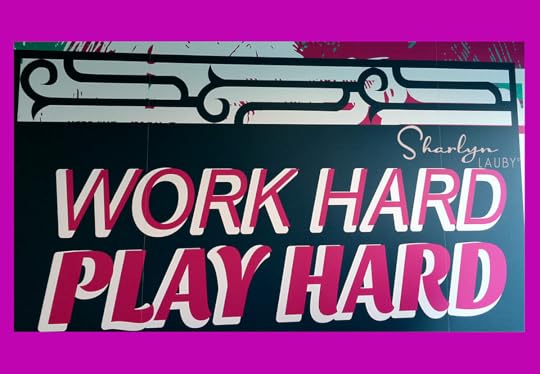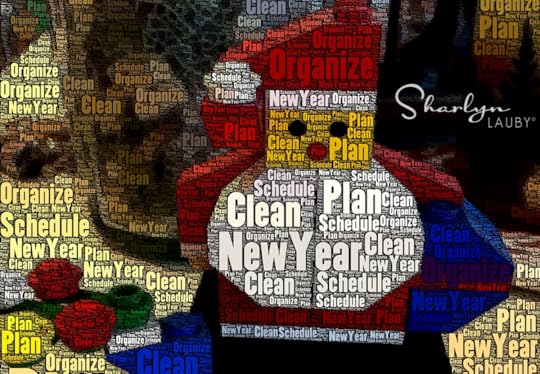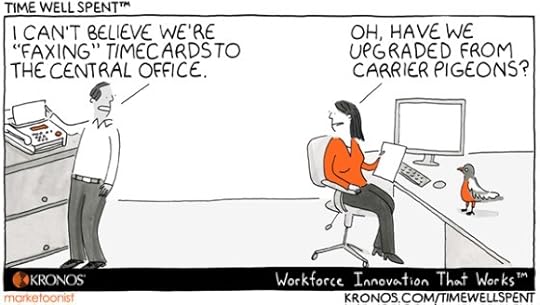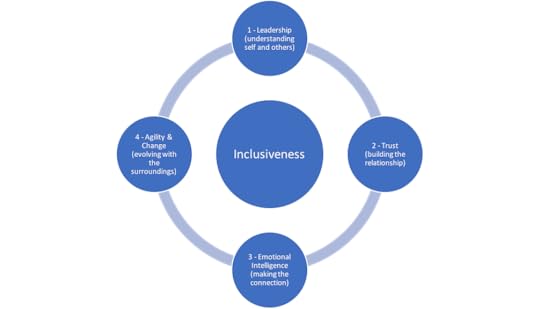Sharlyn J. Lauby's Blog, page 125
December 29, 2017
New Year By the Numbers – Happy 2018 from #HR Bartender [infographic]
The professional side of me always thinks about the New Year in terms of goal setting and strategy. But, I don’t have a human resources or business article today.
New Year’s is about more than business. I ran across this infographic from History.com and thought it was fun. For example, I thought the section on New Year’s foods was interesting. Growing up, eating pork for dinner was a New Year’s tradition. What food traditions do you have? Be sure to share in the comments how you plan to celebrate the New Year!
Mr. Bartender and I want to extend a heartfelt thanks to you for reading and sharing. Your support means so much. We also want to thank the organizations that support and sponsor HR Bartender. It’s with their generosity that we’re able to do this. So, many many thanks to everyone. We look forward to more fun times in 2018.
Cheers from the HR Bartender team! And celebrate responsibly.
The post New Year By the Numbers – Happy 2018 from #HR Bartender [infographic] appeared first on hr bartender.






December 19, 2017
Accountability Isn’t About Putting Things in Writing
I recently wrote an article titled, “5 Key Components of Any Successful Performance Management Process”. The article outlines how to use management involvement, goal setting, learning and development, feedback and coaching, and ongoing conversations to improve performance. I received a note about the article that I wanted to share.
We’re working to become a high-performance company by incorporating the ‘key components’ you wrote about into our leadership’s everyday behaviors, which in turn, will drive performance and desired behaviors. However, the crux of the situation is my senior leadership wants no formal documentation of conversations. Have you seen this executed successfully in other organizations? Any tips to ensure accountability while empowering leaders to truly manage performance?
I think this is a great question because it gets to the heart of accountability. I understand the reader’s point about documentation. Sometimes we are forced to put things in writing to hold people accountable. Other times we want to write things down to hold ourselves accountable.
But we need to be careful that documentation doesn’t become synonymous with accountability. Because accountability isn’t about putting things in writing. At least, that’s not the only form of accountability. Ultimately, accountability is about behavior. When we’re talking about accountability, here are a few things to keep in mind:
Accountability is about accepting responsibility. The definition of accountability is “an obligation or willingness to accept responsibility for one’s actions”. Some people do this naturally or with very little prompting. Others…well, might need more pressure encouragement. Part of the conversation might include explaining the benefits of accepting responsibility, such as “this will make your job easier” or that it reduces a source of frustration.
If you accept this definition, then you realize that accountability and documentation don’t always go together. For example, Mr. Bartender takes out the recycling every week. Not because he’s signed a document. (Oh, wouldn’t that be funny?!) But he holds himself accountable for helping the environment.
Individuals shouldn’t be held accountable for things they cannot control. Let me explain the context of control. We can use the reader’s note as an example. I don’t believe it’s fair to tell a manager, “You will be held accountable for having regular one-on-one meetings with your employees.” And then not allow them a certain amount of flexibility in making that happen.
For instance, one manager might want to have a set date and time that they meet with each employee. Another manager might have a sign-up sheet that employees write their name in. The important thing is that they have the one-on-one meetings.
Accountability must be communicated and properly trained. Whenever someone is going to be held accountable for a task, they need to 1) know that they’re being held accountable and 2) feel comfortable doing the task. Adding to the scenario of manager one-on-one meetings, I could see a manager getting really frustrated if they weren’t told that they needed to be conducting one-on-one meetings with employees. Then they’re dinged for it during their performance review.
I could also see managers (and employees!) getting really frustrated if managers are told that they will be held accountable for one-on-one meetings and then never given any type of training or guidance.
Understand why an individual holds themselves accountable. Organizations could learn a lot by understanding the reasons employees hold themselves accountable for certain activities. It is as simple as “it’s on my job description” or a bigger reason like “Mr. Jones comes into our shop every Tuesday, so I try to make his day special.” If an employee hasn’t told you why they do a particular activity (or it isn’t obvious), ask them.
Managers might learn an extra benefit that they can share with others. It could reveal a reason the employee stays with the company.
Organizations that want to hold managers accountable for performance management need to properly communicate expectations, train managers for competence, and ask them to accept responsibility for the task. If you’re looking to add documentation, that can occur in job descriptions, performance reviews, and manager training. IMHO, the hard part isn’t finding ways to add documentation. It’s getting managers to hold themselves accountable.
Image captured by Sharlyn Lauby after speaking at the SHRM Annual Conference in New Orleans, LA
The post Accountability Isn’t About Putting Things in Writing appeared first on hr bartender.






December 17, 2017
Employee Engagement Will Remain a Top Concern in 2018
I was recently in a meeting with human resources professionals where the subject of employee engagement came up. And it’s obvious after that conversation, the term “employee engagement” has officially jumped the shark.
So, you might be asking yourself, “Then why are you writing about employee engagement?” It’s a great question. The answer is because, regardless of what you call it, employee engagement is important. Organizations want need what engagement creates (even if they don’t like the words). Here’s some articles about employee engagement that can help you create an impactful strategy.
Employee Engagement: The Best Time to Do It Was 20 Years Ago
A highly engaged workforce offers benefits in productivity and retention. So, we know engagement is critical. Here are 7 tips and resources to help.
If you had to explain employee engagement in one sentence, what would you say? The X Model offers a concise explanation of engagement.
Engagement Isn’t a One and Done Activity
Engagement doesn’t come with a switch. It takes planning, nurturing, reinforcement and coaching. Companies should be ready for peaks and valleys.
Employee Engagement Is Everyone’s Job
Employee engagement is more important than ever. Retaining and attracting the best employees requires a great company culture. And that’s everyone’s job.
The Key to Employee Engagement: Your Net Promoter Score
Can you accurately measure engagement? Employee Net Promoter Score (eNPS) links engagement to candidate referrals.
Engagement Surveys: 4 Planning and Execution Must-Haves
We know the value of engagement and using surveys to develop programs. Proper planning and execution is crucial in engagement surveys.
The Single Question that Drives Company Culture
Company culture plays an important role in recruiting and retention. But what drives company culture? Ask one question to help determine your culture.
HOW TO: Turn Your Engagement Survey Results into Action
Engagement surveys give employers a wealth of information. Here are three steps to turning your engagement survey results into action.
Increase Engagement and Retention with Better One-on-One Meetings
Communication helps managers drive employee engagement. One-on-one meetings are more important than ever to grow engagement and improve employee retention.
Organizations Must View Engagement as a Long-Term Business Activity
We know the value of engagement. We must view engagement long term, set realistic expectations, and focus on culture.
Employee engagement isn’t going anywhere. That being said, HR pros and managers have to take engagement seriously. Organizations are spending a lot of resources to achieve the results associated with an engaged workforce. The needle must start moving within our organizations.
If your company is looking for a way to create some momentum around engagement, check out Lori Michele Leavitt’s book, “The Pivot”. It outlines the four stages of a well-orchestrated change along with six key indicators to start tracking. The book includes a code which allows you to take a short (8-minute) assessment that will help with understanding your company’s readiness to take on such a challenge.
Image captured by Sharlyn Lauby somewhere off the coast of Miami, FL
The post Employee Engagement Will Remain a Top Concern in 2018 appeared first on hr bartender.






December 15, 2017
Companies Need Jobs, Employees and Scheduling – Friday Distraction
Today’s Time Well Spent from our friends at Kronos reminds me of that old saying, “Good, Fast, or Cheap – Pick Two”. The saying represents the idea that we can get quality quickly, but it will cost us. If we want it quickly and inexpensively, then it might not be that good. And to get something good at a low price, it might take some extra time.
In this case, we’re applying the concept to staffing the operation. Can we get the right people in the right jobs at the right time? Frankly, it’s hard on three fronts:
Job Design: Organizations have to design jobs that employees want. They cannot be a mishmash of responsibilities with a title attached to them. Employees want to be able to easily explain to others what they do and how they contribute to their company and community. Human resources can play a big role in helping organizations design jobs that employees will want to apply for. Keep in mind, this means that HR needs to stay current with work trends, like technology, so jobs are designed to fill both current and future organizational needs.
Recruiting: Once the company has designed jobs that people want, they must create a strategy to make those job openings known. The unemployment rate continues to drop, meaning that sourcing candidates is getting tougher. It also means letting job seekers know what the company is all about – their mission and purpose. HR and talent acquisition will want to work with the rest of the organization to define the company’s employment brand and candidate experience.
Scheduling: It’s not enough to simply create jobs and hire people. Companies need to make sure the employees are at work when it makes sense for the business. I know this sounds obvious, but we both know that organizations often get it wrong. There’s a difference between staffing and scheduling. Companies can have lots of employees and never schedule them at the right times. OR they can schedule employees at the right times, but not have enough staff.
Like the good, fast, or cheap saying, I wish there was an absolute way to schedule the right employees to do the right work at the right time. That’s what makes workforce management so incredibly valuable. Lucky for us, there are technology tools that can help us to effectively make this business trifecta happen.
The post Companies Need Jobs, Employees and Scheduling – Friday Distraction appeared first on hr bartender.






December 14, 2017
Are External Forces Changing Organizational Values
I want to share with you this high-level thought. I don’t know that I have all of the answers here, but I think as business professionals, there might come a time when we’re asked to weigh in on the concept.
I was at a conference earlier this year where there were several conversations about organizational vision, mission, and values. That totally makes sense because it aligns with what organizations are thinking about. But the discussion was different. It was focused on organizations redefining their vision, mission, and values based on external factors.
Regardless of your political ideology, I’d like to think we can all agree that there’s a lot of change going on. Those changes impact our employees. Just because an organization isn’t legally obligated to provide something doesn’t mean they couldn’t, shouldn’t, or wouldn’t. Many organizations realize that the key to attracting and retaining talent is offering more than what the government requires.
But I sensed from this year’s discussion at the conference that the conversation is getting kicked up a notch. We’re not simply talking about pay, benefits, and perks. Organizational values are changing. The reasons vary – maybe it’s because employees are asking senior management to support a particular cause. Or maybe the organization realizes that their customers are passionate about a taking a stand. It could also be because the community or the government is unwilling or unable to provide support. And organizations feel it’s their obligation to do so.
Changing organizational values doesn’t happen overnight. It’s not as easy as simply making the statement, “We believe …” Organizational values align with the vision and mission. They should be embraced at every level. Organizational values are a part of recruiting, onboarding, training, promotions, etc.
Now, it’s possible that what’s taking place is the organization is taking a position about something which is either being misinterpreted as a change in organizational values OR will eventually become a change in organizational values. Either way, communication needs to take place so employees understand the company’s actions.
One area where organizational values have a huge impact is corporate social responsibility (CSR). According to the Society for Human Resource Management (SHRM), corporate social responsibility falls under the competency model for human resources professionals. That means that HR needs to be aware of this trend, and be prepared to have an opinion about it. It might be beneficial to start thinking about what your answer will be if you get asked the question.
Organizations are still testing the waters where this is concerned. Sometimes their actions are perceived as positive and other times considered woefully inadequate. But make no mistake, the conversations are happening and organizations have to figure out their involvement.
Image captured by Sharlyn Lauby while reading, questioning and thinking.
The post Are External Forces Changing Organizational Values appeared first on hr bartender.






December 12, 2017
Onboarding Is Successful When Expectations Are Met
I think as a general rule, people are happy when their expectations are met. If Mr. Bartender and I go out to dinner, we expect a nice meal. When our expectations are met, we’re happy. When they aren’t, we’re disappointed.
Same happens with candidates. When they accept a job offer, they expect to like their job and the company they’re working for. When that happens, they’re happy and engaged. When it doesn’t, they are disengaged and eventually leave. Or maybe they are disengaged and stay. Either way, it’s not good.
Hiring managers have expectations too. I’ve never met a hiring manager that extends an offer to an employee thinking, “I expect this candidate will be a real loser. Their performance will be awful and in a few months, I’ll have to start performance managing them out the door.” No, managers hire employees with the expectation that they’ll learn about their job, like their work, and perform well.
All of this points to the onboarding process. Onboarding sets the stage for expectations to be met or disappointment to start sinking in. So, organizations need to ask themselves, “What does onboarding mean to our organization?” Not the process, but what’s the expectation. Processes can change. Organizations should strive to find out these two things:
What do new hires expect during onboarding? I can see some common responses including how do employees get paid, when do employee benefits start, and how do employees do their job.
What are manager expectations for onboarding? Common responses are building relationships with employees, training new hires on their job duties, and communicating the company performance standard.
The answers to these questions will impact WHAT takes place during onboarding. And WHEN it happens. Oh, and HOW it’s communicated. Even WHO is responsible. An organization might decide to add a technology solution to handle preboarding. Orientation might be shorted to a couple of hours on day one with a follow-up session a few weeks later. Managers might decide to team teach sections of orientation with HR. All in the realm of possibilities, if the organization knows what is expected.
So, add a piece to your current onboarding process. Get feedback from both employees and managers. Find out from employees if the organization is delivering what the company promised. Ask managers if new hires are developing on the job as expected. Let me also suggest that it might make sense to do this several times during the first six months of employment. Everything could be fine during the first month; only to not be fine at 90 days.
Employee onboarding is about setting expectations. Failure to do so will only lead to disengagement and disappointment by employees and managers.
Image captured by Sharlyn Lauby while exploring in South Florida
The post Onboarding Is Successful When Expectations Are Met appeared first on hr bartender.






December 10, 2017
How to Spend the Last Two Weeks of the Year
When I worked in Corporate America, I often worked during the last two weeks of the year. At first, because I had to. Everyone else had more seniority and vacation time. Later in my career, I did it because I wanted to. The last two weeks of the year are so nice and quiet. Fewer meetings. Less email. I could catch up and cross off a few things on my “to-do” list.
So, if you’re looking at your schedule for December and unhappy about having to work while your colleagues are taking time off, let me share a few things you can do to prepare for the upcoming year. (In fact, you might want to bookmark this page and use it as an end-of-the-year checklist.
Clean out your contacts. I’m not talking about unfriending or unfollowing people. This refers to contacts with outdated information and they haven’t stayed in touch. That Outlook entry is just taking up space. If you want, reach out and try to connect with those individuals via LinkedIn. Then you will always have their most current contact information.
Update your social media accounts. Use the quiet time to unfriend, unfollow, unlike, etc. those accounts that don’t bring value. Also take a moment to update your bio and contact information. The more accurate and up-to-date your profiles are, the more people will want to engage with you.
Get your planner ready for the New Year. While I have an electronic calendar in Outlook, I still like using a paper planner. There are many different styles available: Passion Planner, Plum Planner, Erin Condren, etc. Planning is an important activity that helps us achieve our goals. Find a system that works for you.
Do a mini-HR audit. Pull a half dozen personnel files and make sure they look the way they’re supposed to. You can do the same with Form I-9. It’s better to have some sense of how your files look before an official audit. Need an audit checklist? The SHRM Knowledge Center can help you with that. Members are able to request information for free!
Organize your reading. I don’t know about you, but I find that during the year, I add blogs to my Feedly and then discover the blog has been abandoned, etc. So, it’s good to clean out those electronic newsletters and blogs to make room for new ones. (Hopefully you’ll continue receiving HR Bartender!)
Clean and dust your office. Another area that I’m guilty of neglecting. Books get dusty. Computer cords get tangled. Take a couple of hours to move stuff and really clean. You’ll be amazed how good it feels (and smells!)
Delete electronic files that you no longer need. A word of caution here – please check with your legal counsel and/or IT before doing this. But my guess is the company’s 1986 dress code policy that is still sitting on your computer could be deleted. Organizing your electronic files will make you more productive.
Schedule one-on-ones with employees. I know that much of what we’ve discussed so far is about organizing paper. Remember management by walking around (MBWA)? This is also a great time of year to get out of your office and talk with employees. Find out what’s going on.
Schedule one-on-ones with managers. Speaking of meetings, use the last two weeks of the year to meet with the managers that are also working. Talk with them about how HR can help and provide value. Plan some strategies together. A big part of HR’s job is building relationships. Here’s a great opportunity.
Take a class. Been trying to find a few hours for your own professional development? I know how hard it can be to squeeze time into an already busy schedule. Use the slow time to listen to an online seminar or take a MOOC (massive open online course).
While we’d all like to spend the last couple weeks of the year on a tropical paradise, it’s simply not always possible. So, if your plans involve work, use the time to your advantage. You can start the new year ready to make a huge impact.
Image captured by Sharlyn Lauby a little bit south of the North Pole
The post How to Spend the Last Two Weeks of the Year appeared first on hr bartender.






December 8, 2017
Technology Is Part of Your Employment Brand – Friday Distraction
(Editor’s Note: Today’s article is brought to you by our friends at Kronos , a leading provider of workforce management and human capital management cloud solutions. This week, Kronos ranked on Glassdoor’s annual listing of the Top 100 Best Places to Work in the U.S. as a top employer in the software industry . While this is the first time Kronos has cracked Glassdoor’s Top 100 Best Places to Work list, . Congrats to them! Enjoy the article.)
There has been much conversation about the digital divide – the widening gap between those who have technology (specifically the internet) and those who do not. The activities and access we have simply because we have internet is mind boggling.
As such, it might seem obvious that the ability to successfully use technology is important. Possibly even something we take for granted. For example, how many times do we assume that someone knows how to use the Microsoft Office Suite. According to this 2016 article, eighty-five (85%) of the Fortune 100 uses Microsoft Office. That’s a lot, but it’s not everyone.
Which brings me to today’s Time Well Spent from our friends at Kronos. I couldn’t help but laugh at the “fax” reference. Personally, I don’t remember the last time I faxed anything. But for some businesses, faxing is still an important way to send information. However, if your organization is in the “faxing” camp, let me toss out a couple of thoughts to consider:
The kind of technology your organization uses says a lot about your company. If your business is using old hardware and software, candidates might assume that your company is behind the times. Is that the message that you want to send?
If technology does help employees work faster and smarter, does a lack of current technology send a message about the company’s view on employee development? What I mean by this is … could workplaces that drag their feet on giving employees tech be perceived as not caring about employee morale and wellbeing? Why make employees do double or triple the work if a technology solution can help produce results faster?
Organizations that aren’t willing to test and try new technologies could be viewed as resistant to change. This isn’t to say that companies need to be early adopters of every new shiny technology on the market. But companies that aren’t willing to explore could be seen as dinosaurs.
I’m not saying a business that doesn’t have the latest and greatest technology is doomed. But I do think it could make sense for organizations to ask themselves if technology is keeping them from attracting, engaging, and retaining the best talent. Something to think about.
The post Technology Is Part of Your Employment Brand – Friday Distraction appeared first on hr bartender.






December 7, 2017
The Culture Series [Part 4] – Implementing an Inclusive Culture
In the second and third articles of the series, we talked about the four competencies that are key to the organization’s cultural identity. Once that happens, the work isn’t over. Future policies, procedures and strategies need to reflect how trends will impact the organization over time. For example, if the organization is planning to expand into the Latin American market in the next 5 years, what is the company doing today in terms of understanding the Latin American culture to ensure their success?
One of the biggest challenges to creating an inclusive culture is the nebulous nature of diversity training and activities. The chief complaints are that the business definition for diversity isn’t well-defined (which we talked about in the first post of the series) and focuses too much on legal and compliance issues, which is one of the reasons we’re not talking about them in this series.
I had the opportunity to hear Corey Anthony, senior vice president of business services at AT&T, talked about bias at a conference earlier this year. He said that it’s very hard for companies to know everyone’s biases. But that organizations can create an environment where people are able to discuss bias, focus on behaviors and changing behaviors, and create opportunities to listen and not label.
This doesn’t mean that diversity training efforts should be eliminated. In fact, it’s a call to action that diversity programs gain clearer focus to become more effective. A few elements to concentrate on when developing diversity training include:
Clear objectives and expectations
Participant engagement before, during and after the session
Opportunities for open discussion and dialogue
Creative activities and sharing within a safe environment
Facilitation of hot-topics and challenging conversation that emerges during the session
Support and positive energy by everyone involved
While there are clear recruiting and retention benefits to creating an inclusive culture, it’s important to recognize that this isn’t exclusively about recruiting or retention. It’s about transforming the culture of the company into one that’s customer-centric, business-focused, and leadership-focused. If you haven’t seen it, Randall Stephenson, CEO of AT&T, made headlines with his speech about race relations and defense of Black Lives Matter.
It’s clear that having a diverse workforce and creating an inclusionary culture yield huge rewards for companies. The challenge is clearly defining what that means for your unique corporate culture, designing efforts that align with the business goals and constantly measuring and evaluating results.
Organizations need to consciously revisit their efforts to ensure they are creating a sustainable culture. Maintaining an inclusive culture is not a one-time conversation. Companies will want to evaluate their energies at several levels on a regular basis. A few questions you should consider:
How can the company attract and retain the talent necessary to meet our current and future business goals?
How can the corporate culture support the products and services our customers want?
How can the organization drive innovation and growth by leveraging our diversity efforts?
How can we expand our business reach into new markets?
William Morgan, former senior vice president of human resources at NASDAQ, shared how their cultural transformation translated into business success. “We saw how we could better leverage our diversity efforts to impact our business bottom-line. Not only did we identify our opportunities to improve, but we provided specific measurable actions we can take along with easy-to-measure outcomes. We found ideas were practical and well aligned with our other business priorities.”
Successful organizations understand that inclusion is not optional – it’s a business imperative that gives them a competitive advantage with stakeholders at every level: customers, suppliers, partners, and employees. Diversity and inclusion are no longer programs within an organization. They are infused within the culture of the company and drive business outcomes.
Image captured by Sharlyn Lauby at the 34th Street Graffiti Wall in Gainesville, FL
The post The Culture Series [Part 4] – Implementing an Inclusive Culture appeared first on hr bartender.






December 5, 2017
There’s No Silver Bullet for Hiring the Best Talent
(Editor’s Note: Today’s post is brought to you by our friends at Criteria Corp, a leading provider of pre-employment testing services. They recently launched an app called JobFlare (iOS, FREE) that allows users to play “brain games” that are scientifically created to test the cognitive abilities that are considered the key predictors of job success. Enjoy the post!)
You might be wondering about the title of today’s post. The term “silver bullet” has become an American expression meaning a quick, simple, and seemingly magical solution to a complicated matter. The reason I’m bringing this up is because it might be tempting to think of pre-employment testing as a silver bullet. But it couldn’t be further from the truth.
According to Josh Millet, CEO of Criteria Corp, when a testing provider tries to sell you their services with the promise “never make a bad hire again”, you should run, not walk in the opposite direction. “Testing isn’t a crystal ball, and that’s not how the science of employee selection works. Incorporating pre-employment tests into the hiring process is about making more informed decisions and maximizing your chances of hiring people who are likely to succeed. Think of it like improving your batting average.”
This raises the question, what can organizations do to improve their recruiting processes and select the best talent? One way is to use pre-employment tests as a way to predict learning potential. In the Society for Human Resource Management (SHRM) study “The New Talent Landscape: Recruiting Difficulty and Skills Shortages”, sixty-eight percent (68%) of respondents indicated that they are experiencing challenging recruiting conditions.
I can see organizations being faced with a hiring dilemma. Do we hire Candidate A, who has 80 percent of the skills and provide them with training for the remaining 20 percent? Or do we leave the position vacant until we find a candidate with everything we’re looking for? Pre-employment tests can help organizations hire a candidate with the potential to be a rock star and allow them to invest in their development.
Avoiding the Bad Hire is Essential
Millet says the other way to improve hiring is by reducing risk. “Ultimately, it’s not about hiring the perfect person every time, it’s about improving the number of good people you get in the door and avoiding the truly toxic hires.”
And bad hires are expensive.
In an article on Business Insider, Zappos CEO Tony Hsieh says that bad hires have cost his company “well over $100 million.” Arte Nathan, former CHRO for the Wynn Las Vegas, points out in a SHRM article that bad hires impact the entire organization. “Most companies don’t know the full cost of the turnover, so they don’t apply the resources upfront to avoid it. If you make a bad hire, there is a ripple effect among all who work for you, your product and your product quality.”
While using pre-employment tests to predict learning potential and reduce risk aren’t mutually exclusive, let’s focus today on some of the hiring tactics designed to reduce risk and how pre-employment testing can mitigate workplace injuries, employee errors, employee theft/fraud, in addition to the cost of a bad hire. Mitigating risk, especially when it comes to employees, can mean different things in different industries and occupational settings, and is dependent on the business outcomes you’re trying to achieve. For example:
Manufacturing: It’s important to hire employees who are more likely to follow the company’s rules and avoid safety accidents. Workplace accidents and incidents can harm human lives, which lead to higher workers’ compensation claims and can be costly (among other things).
Retail: I think it goes without saying, but let’s say it anyway. Organizations want employees who are less likely to steal inventory, cash, or customer data.
Technology: Companies want to hire software engineers and workers who can motivate and push their teams to deliver projects on-time and within budget without making coding mistakes that could jeopardize security.
Marketing: Organizations want to hire public relations and social media managers who are not prone to posting inaccurate or inappropriate content, which could damage the company’s consumer brand.
Now, I know what you’re thinking. And you’re right. Simply using pre-employment testing won’t magically prevent you from ever making a bad hire again. But testing can provide a way to reduce the overall risk an organization faces each time they hire someone. Pre-employment tests provide a data-driven way to way mitigate risk because they are correlated with reducing these types of risks.
One final thing – I wasn’t aware of this, but some insurances companies that write business policies give discounts to companies that use tests in the hiring process. Criteria Corp shared with me that they have a partnership with an insurance company that specializes in professional liability insurance and risk management services, and they actually provide discounts to their customers who use their integrity tests to hire employees because those tests are correlated with reduced risk.
Reduce Risk to Increase Employee Retention
Organizations today are focused on retention. That means making the best hire possible. No one wants to spend all that time and money hiring someone to have them leave after six months or a year. However, hiring the best talent involves mitigating risk so the company can avoid hiring a toxic, unproductive employee who brings down the entire organization. Pre-employment testing is one way to do it.
Pre-employment testing is a complex topic. Luckily Criteria Corp has created a “Definitive Guide to Pre-Employment Testing”. Download a copy to learn more about the benefits of pre-employment tests. And be sure to follow their blog to learn even more.
The post There’s No Silver Bullet for Hiring the Best Talent appeared first on hr bartender.






Sharlyn J. Lauby's Blog
- Sharlyn J. Lauby's profile
- 10 followers















